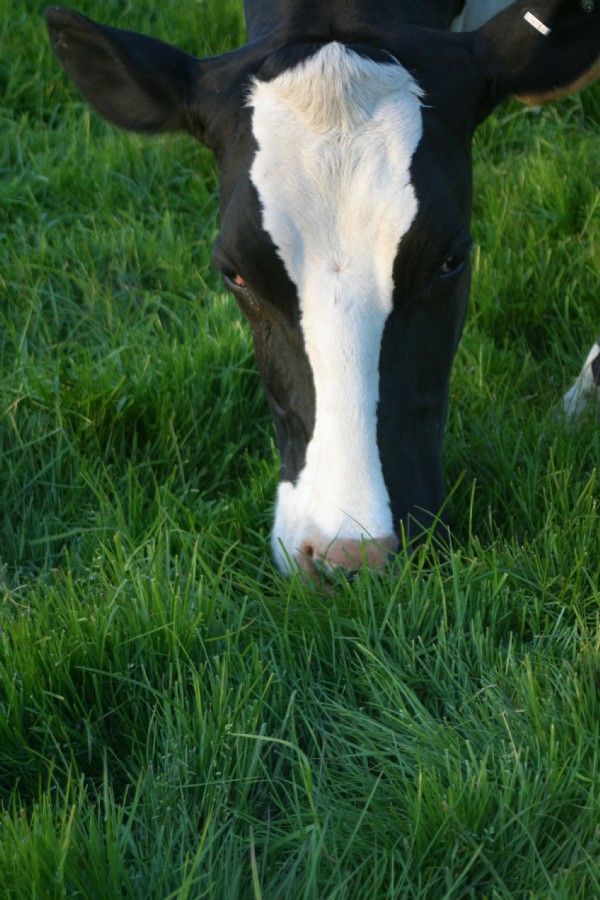

Grassland accounts for two thirds of the agricultural land in the UK and supports about £10 billion worth of ruminant products per year, which represents 60% of the UK agricultural output. An estimated 35% of the total cost of ruminant production is the cost of feed and 75% of the feed requirements are presently obtained from the grass and forage, although this varies from around 60% of the feed for dairy cows up to 90% for sheep. Of the grass species sown, ryegrasses are by far the most important and have the potential to provide most of the feed required to support efficient and environmentally friendly milk, meat and wool production in the UK.
Suitable For Grazing
The need for livestock farmers to produce more feed on-farm is increasing through economic necessity and for reasons of accountability. Grazed grass is by far the cheapest way to feed cows, cattle and sheep.
Or Excellent For Cutting
Plant breeding at IGER, Aberystwyth has combined the high yield potential of Italian ryegrass with the persistency and quality of perennial ryegrass in stable tetraploid hybrids which show improved adaptability to cutting and grazing managements. During the growing season, hybrids behave in a similar way to Italian ryegrass up to flowering, after which there is a change in growth form towards that of perennial ryegrass to produce a leafy re-growth in the mid-season, which increases nutritive value and promotes persistency. There is increasing appreciation among grassland farmers of the extent to which tetraploid hybrid ryegrasses can maintain productive swards during extended growing seasons and thus reduce the need for conserved winter feed. Hybrids can meet any additional requirements for winter feed from two or three highly productive silage cuts in May-August period, at a cost of about £60/tonne dry matter, thus providing a complete forage feed package on farm.
Breeding Hybrid Ryegrass
The first hybrid ryegrass varieties produced at IGER, such as Augusta, tended to be more like an Italian ryegrass parent and were widely used in management systems where high quality, conserved forage was important. IGER is now producing a wider range of more intermediate hybrid types with a spread of flowering to allow greater flexibility in the timing of cutting, with good grazing potential. As well as providing a wider range of heading dates than Italian ryegrass, Hybrids allow wider flexibility in the timing of silage cuts because digestibility declines more slowly during crop maturation compared to Italian ryegrass.
Breeding achievements
Early spring growth and the first and second conservation cuts from tetraploid hybrid AberExcel can be 20% higher than from an intermediate heading perennial ryegrass in the 3rd harvest year. Total dry matter yield in the third harvest year from Italian ryegrasses are generally 15% lower than from tetraploid hybrids and is associated with a lower percentage ground cover.
These are major improvements in seasonal performance compared with the earlier bred hybrids. Improvements have also been indicated in mid-season D-values of the hybrid variety, AberLinnet, compared with other hybrid ryegrasses, Molisto, Polly and the tetraploid Italian ryegrass Fabio.
Hybrids such as AberEve, AberExcel and AberEcho are now available to UK farmers and have the following significant advantages:
a) High conservation yields for 2-3 cuts of good quality silage
b) Good productivity throughout growing seasons for efficient use of nitrogen and other nutrients
c) Early and late growth to extend the growing season
d) High leaf (low stem) content ensuring high digestibility throughout the year
e) High soluble carbohydrate content for good silage fermentation and efficient ruminant digestion
f) Good tolerance to environmental stress and disease resistance, resulting in good persistency for swards of 4-5 years in duration.
Clover Mixtures
Tetraploid hybrids grow well with clovers on account of their open sward. The range of varieties produced at IGER allows mixtures based solely on tetraploid hybrids to be considered. Seasonal growth of swards may be improved by growing mixtures of different hybrid varieties which have a range of heading dates and a range of Italian and perennial ryegrass characteristics. In comparison with monocultures, mixtures can demonstrate clear advantages in terms of yield within a year and consistency of yield over years, particularly in the critical mid-season period. The ability of hybrid ryegrasses to grow well with clover is also important as the readily available energy provided by hybrids can be balanced by clover protein to provide a complete forage feed on farm. Initial work at IGER indicates that hybrid swards can maintain a higher clover content than Italian ryegrass while maintaining a higher yield than perennial ryegrass.
It's beneficial to sow persistant hybrid ryegrass seed in mixture with more persistant red clovers such as Milvus. This has resulted in improved grass yields over a three - four year period. That's nearly double the life of the traditional two year red clover ley.
Conclusions
Farm-grown forages, rather than bought-in concentrates, play a vital role in UK livestock farming. We have shown that tetraploid hybrid ryegrasses produce high yielding and high quality swards for flexible grazing and silage management systems. Increased consistency of yield from hybrids, both between and within years, will encourage confidence in livestock farmers to increase the utilisation of grass.
Hybrids give good yield in early spring, in the critical mid-season period, and in the autumn for extended grazing seasons. They also maintain high yields of good quality silage extending into the fourth harvest year and beyond, based on a persistent ground cover and as a cost effective and sustainable feed for ruminants.
By Ian Wilkinson of Cotswold Seeds
Date Posted: 29th March 2017




